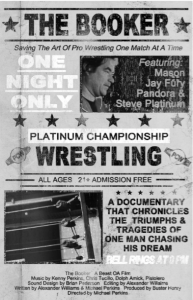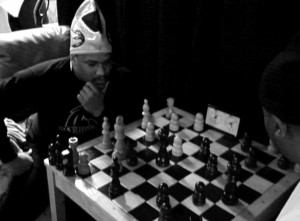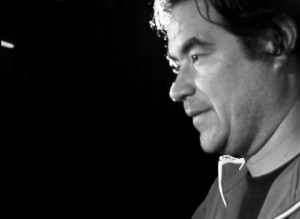When the Platinum Championship Wrestling documentary The Booker screens at the Midtown Art Cinema at 7:15 tonight as part of the Atlanta Film Festival, it will be the world premiere of a movie that was four years in the making. In the film, director Michael Perkins of Beast OA Films and Studio 5 begins in 2008, when Stephen Platinum began his quest to make PCW an  alternative to what passes for pro wrestling today. The movie concludes with 2010’s Sacred Ground: Chapter One, an event held at the Kennesaw State University Convocation Center and featuring some of wrestling’s top independent stars taking on PCW’s top talents. What’s most interesting, however, is the struggles that take place for Platinum and other PCW members as they try to make their dream a reality.
alternative to what passes for pro wrestling today. The movie concludes with 2010’s Sacred Ground: Chapter One, an event held at the Kennesaw State University Convocation Center and featuring some of wrestling’s top independent stars taking on PCW’s top talents. What’s most interesting, however, is the struggles that take place for Platinum and other PCW members as they try to make their dream a reality.
Though PCW still has a long way to go before becoming a viable alternative to mainstream wrestling, it has definitely established itself as one of the top promotions in Georgia, and one of the most active promotions in the country. Perkins and the PCW crew have plenty of reason to celebrate tonight, which is exactly what they will be doing when they head over to the Wrestling with Pop Culture Anniversary Party, which is the official Atlanta Film Festival afterparty for the screening of The Booker. A limited number of autographed copies of the film will be available on DVD, but the challenges PCW faces in the film will pale in comparison to what these guys will face at the Masquerade tonight with Monstrosity Championship Wrestling. Before you go see the movie or head to the afterparty, here’s an interview Matt Hankins, dany only and I did with Perkins on the March 19 edition of Georgia Wrestling Now about tonight’s screening and afterparty.
You’ve made some other documentaries about Motocross and other subjects. What attracted you to professional wrestling and specifically to Stephen Platinum and Platinum Championship Wrestling?
I grew up in the South and watched Joe Pedicino and Boni Blackstone every Saturday night, so I’ve always been a fan of professional wrestling. I knew Steve because he had done some voiceover work for me. I met him through some friends at Dad’s Garage and I really didn’t now about his professional wrestling background. I just knew he had a great voice and after working with him a little bit I found out more about PCW and the timing was perfect because I was really looking for something I could spend a couple of years on. Steve said, “Yeah, I’m getting my wrestling school back together” one day and I said, “Hey, I could make a documentary about that.” He was probably just humoring me at that point, thinking, “Tthere’s no way this guy’s going to stick around.” We were filming for about four years, but he was really good about keeping a dialogue and letting me know what was happening. It just kept rolling until I decided that Sacred Ground: Chapter One would be a good stop for us to cap our story. I really think about the movie itself as an origin story of PCW and Steve chasing his dream of being a big wrestling promoter and actually doing something that’s good.
The Booker was shot entirely in black and white. Why did you decide to shoot it that way?
The decision to go with black and white for the movie was made about a year into filming. The way we shot the film was a very fly-on-the-wall style. We couldn’t set up a lot of lights because the camera was moving around all the time and a light on the top of the camera was deemed to be too invasive to get the wrestlers to forget about the camera. With so much of the action in our film being in dark or under-lit rooms, we knew that we were going to have to bump up the light in post. This can be done with color footage, but after doing a few tests in black and white we were really blown away by the contrast and grain that we could achieve. That, coupled with the fact that pro wrestling is a seedy business made even more evident in black and white, helped us really hone in on the look that we wanted for the film.
You recently returned to Academy Theatre after an absence of a few months. Now that Empire Wrestling is in charge, how do you think things have changed since you finished the movie?
I saw a lot of new faces. There’s a constant turnover of people coming in and out, people getting injured. That’s the biggest thing I’ve noticed, especially since Empire, but even since Sacred Ground: Chapter One. I go in and I’m like, “Hey, who’s this guy. Wow. I wish you had been around a few years ago.” And there are people that aren’t there anymore that I miss seeing. Overall, it’s just getting better. It’s grown a lot, the stories get more complex and when you add in the Surrealists, you’re not getting anything like that in any other wrestling promotion. I think it’s going in the right direction and one day the right guy is going to see that promotion and go, “You know what? With a couple of dollars, this thing could be huge.” The content is there, the ideas are there and, I don’t know about you, but I love seeing these tiny dudes wrestle, I love to see the big tubby guys wrestle. That’s what it was when you go back to the NWA and the World Championship Wrestling that I watched in the ’80s. Now everything is just big musclebound guys with spray-on tans that use their real names. But in PCW you never know what you’re going to get.
There are scenes in The Booker that really give you an unprecedented look backstage. Have you had any negative feedback from the wrestling community seeing that some people are still very protective of what goes on backstage?
Again, I think you’ve got to go back to PCW being a unique atmosphere. I don’t think I would have gotten that level of access at another promotion because of … the idea of carrying a story all the way through to the parking lot when you’re getting in your car. But I haven’t really gotten any blow-back from that. Most of the wrestling journalists I’ve talked to have been very positive. I think that barrier had been broken already with Beyond the Mat, where they spent a lot of time with Jake Roberts and Mick Foley. That wall had kind of been broken, people knew what was going, so there hasn’t really been any kind of push-back. At least none voiced to me. I’ve had many other critiques and criticisms about the movie, but none of it has been anyone saying, “How could you let the public in on our secret?” Everybody knows it’s a show, but that doesn’t take away from the physicality and theatrics that are involved.

Why is Jay Fury wearing a Warhorse outfit? I guess he just does that when he plays chess with Geter.
That was one of the things that was really nice about working with the folks at PCW was that I explained to them what I was trying to do. I’m not Michael Moore, I don’t want to make you look dumb, I want to talk about this as an art form. I think once they saw that, and saw that I kept coming back show after show, they realized, “OK. This guy’s for real. This isn’t ‘gotcha’ journalism.” But it took nine months to a year of being around before the wrestlers really started to open up to me. And that was a watershed moment. I remember coming back from a shoot at Sam Stone Studios and my wife was like, “How’d it go?” And I said, “People actually opened up to me tonight.” After people really started interacting with me, it became a lot more fun and a lot more enlightening.
You were there so often you must have had a ton of footage that wasn’t used. Will we see any of that in an extended DVD release?
I think we had 63 hours of footage that had to be cut down to an hour and a half. During that process, me and my editor, Alex Williams, said, “Let’s just put the movie together however we want to put it together, then we’ll cut back.” After our first round of editing, we were at about an hour and 57 minutes. So entire sections of the movie were cut out because we’re trying to appeal to as wide an audience as possible and get it down to a reasonable amount of time. The hope is that when we sell it to a distributor, we can put some of that on as extras. And if in five years this movie has a cult following, I can come out with all the extra footage. But starting out, we wanted to make it where pro wrestling fans would like it and appreciate it, but also where my mom could watch it and go, “Oh, this is an interesting story about an interesting guy.”
The title of the movie is rather striking, especially to wrestling fans. How did you decide on that name?
My editor and I were just kind of looking at each other going, “What the hell are we going to call this thing?” We had been going with the working title of PCW Movie, but that doesn’t sell. So we brainstormed for a couple of weeks and I happened to be cleaning up the office one day and[came across] the second tape I ever shot at Steve’s house. It was labeled “The Booker” and I thought, “Wait a second. That’s a great idea!” But it just goes to further prove the point that we started out with “This is going to be about Steve and about booking wrestling,” then it morphs into people who are doing wrestling, then when you finally get into editing everything down, it’s back to what it originally was.

